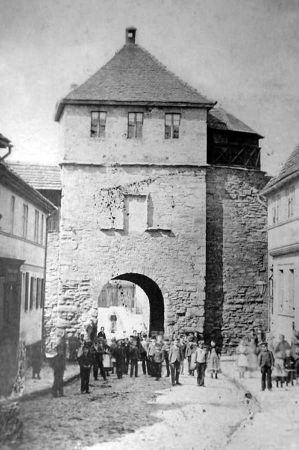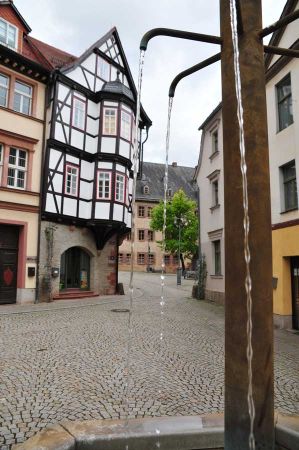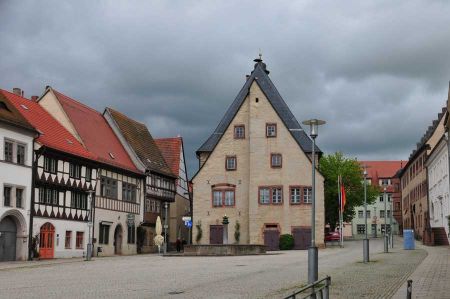Sight-seeing in Sangerhausen - despite the cool weather
- Written by Portal Editor
Once again for reasons of direct regional exploration in Sangerhausen on the way, we liked to go to the Rosarium in Sangerhausen, the well-known and worldwide unique rose garden complex (as we had already reported on this).
Despite Corona, the outdoor area of the rosarium was open, but the cool weather of the past few days had prevented the countless types of roses from blooming, so we wanted to postpone the visit into the near future. On the spur of the moment, we went to the city center of Sangerhausen as an alternative, which we found almost deserted! Probably because of the low temperatures for the time of year, too. Well, it's always a question of clothing, that's our motto.
Medieval and half-timbered houses in Sangerhausen

The origin of the place Sangerhausen probably goes back to a Franconian foundation, because there is a settlement being mentioned for the first time in a document book of the monastery Fulda created between 780 and 802. In a register of the tithe (for tax liability) of the Hersfeld monastery, which was created between 881 and 899, Sangerhausen is named as a place with a liability of ten, Sangerhus im Friesenfeld. In 991 the village then belonged to the Memleben monastery. From the 10th century there was a Fronhof in the area of today's Ulrich Church.
The Fronhof is an estate that was in the center of a medieval village. It was the economic and lordly center of a court association and relied both on its own economy and on the compulsory services of serfs.
Taxpaying Fronhöfe and self-management

The field work was done one hand by unfree farm servants who permanently lived on the Fronhof, and on the other hand supported by the slave farmers who, in addition to their labor for the Fronhof, also managed their own farmsteads. The Fronhof was at the same time the center of a number of smaller farms that were given out by the landlords to peasants liable to pay interest and managed by them for their own account, while the landlords paid the landlords in the form of compulsory labor, about a weekly number of days in the tensioning service, as well had to pay through basic interest. From this subdivision into Fronhof and dependent Hufen, the term two-part manorial rule is derived. Larger mansions, the center of which was the manor house, consisted of a large number of such economic units, sometimes entire networks of court associations, with several Fronhöfe being subordinate to one Oberhof.
After Sangerhausen was granted market rights between 1004 and 1017, a market town emerged in the area of today's Old Market. As a result of the influx of merchants, this grew together with the Fronhof in the north.
Market law and coinage come to Sangerhausen
In 1194 the village was granted town charter. In 1204 the current city was protected by a palisade fence, and in 1263 it was given a city wall. Silver and copper mining has been an important industry in the region since the Middle Ages. In 1391 groschengeld was minted for the first time in the history of Meissnian groschen outside the state mint in Freiberg in the newly established mint in Sangerhausen. The new coin was built for payment obligations in the Harz silver mining.
Reformation and witch trials
Witch hunts took place in Sangerhausen between 1536 and 1710. 22 people, 17 women and five men, got into witch trials. At least three women were cremated, one woman and three men were beheaded, and two women died under torture. Jutte Stulzingk was burned as the first victim in 1536. Similar trials took place in the district of Grillenberg between 1607 and 1614: a woman accused of being a witch was burned, another expelled from the country.
The importance of mining gradually declined by the 19th century. In 1815 Sangerhausen became Prussian and the administrative seat of the district of Sangerhausen in the administrative district of Merseburg in the province of Saxony. The connection to the railway network took place on July 10, 1866 through the Halle – Hann.-Münden railway line. In 1880 the railway line to Erfurt was added. Industrialization led to the establishment of factories that made files, bicycles, malt, pianos, machines, furniture, leather, cheese and sugar. In 1903 the Rosarium was founded in the east of the city.
Please also read:
We follow the signs to the Heldrungen Water Castle
Rentina Castle - Roman Via Egnatia towards Kavala
-
-
-
-
-
-
-
-
-
-
-
-
-
-
-
-
-
-
-
-
-
https://www.alaturka.info/en/germany/thuringia/5377-sight-seeing-in-sangerhausen-despite-the-cool-weather/amp#sigProIdadfabab8b0
